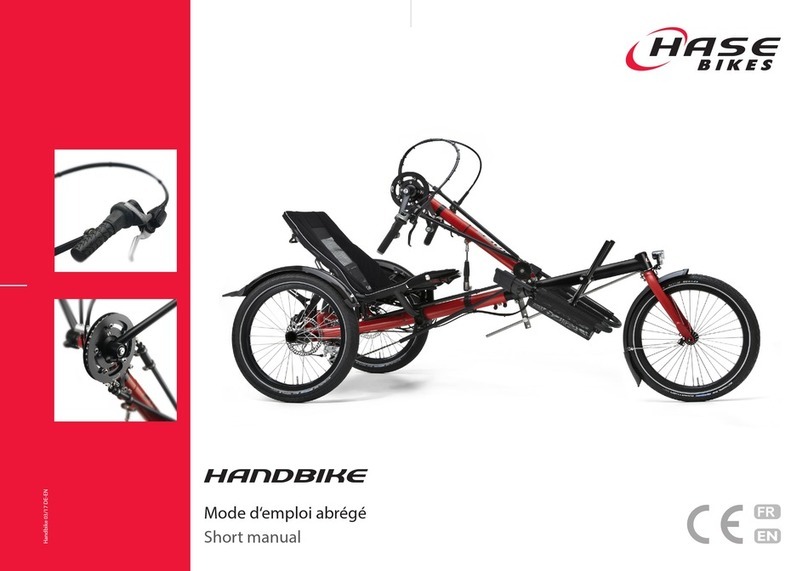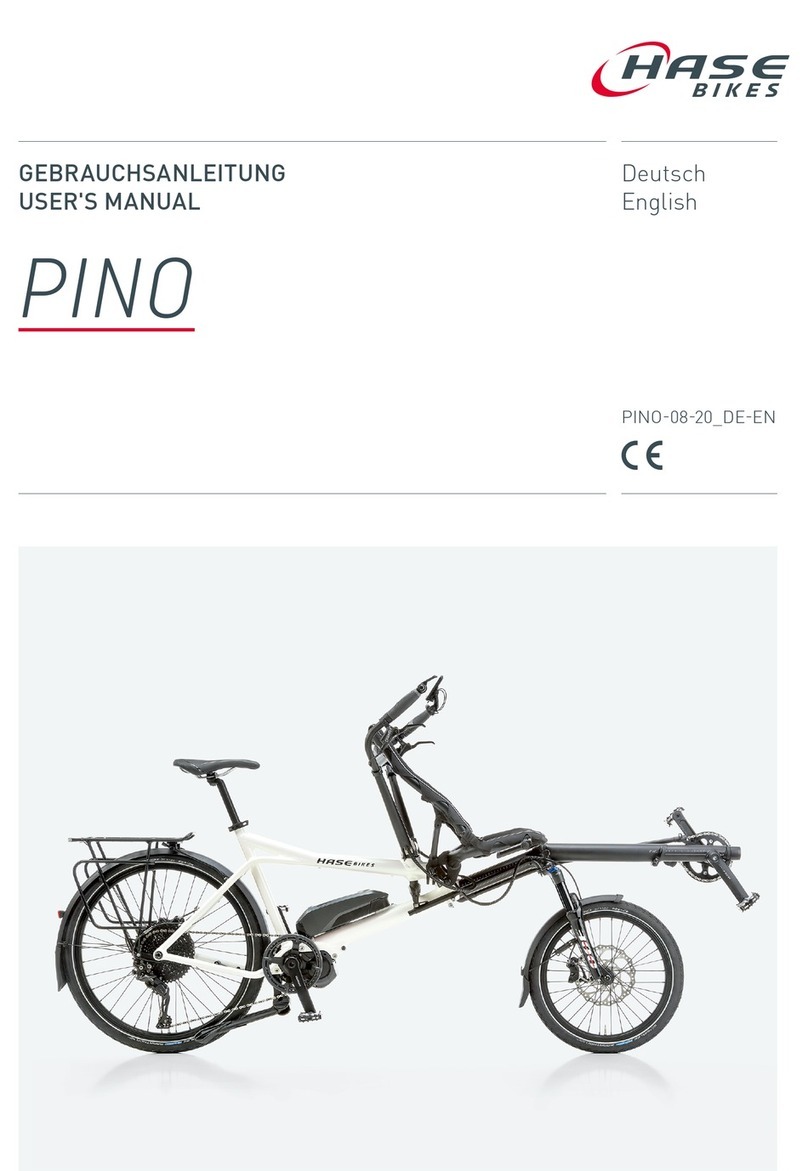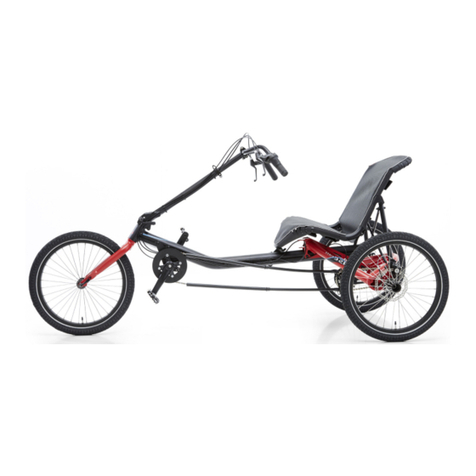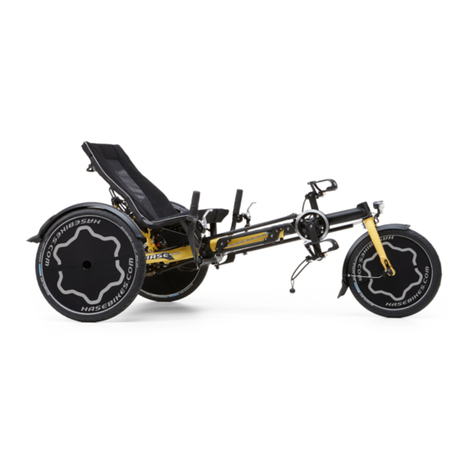HASE Bikes HANDBIKE How to use

Handbike 03/17 DE-EN
Kurzanleitung
Short manual
HANDBIKE

www.hasebikes.com
Handbike 03/17
HANDBIKE
Fußstützen
Footrests
Handkurbeln
Hand-crank arms
Mountain-Drive-Getriebe
Mountain-Drive gear system
Lenkung/Handantriebsholm
Steering/crank column
Bremsgriffe
Brake levers
Hauptrahmen
Main frame
Rahmen-Vorbau
Front boom
Sitzverstellung
Seat adjustment
Diese Gebrauchsanleitung ist eine Ergänzung der Gebrauchsanleitung des Kettwiesels
und enthält nur die Besonderheiten des Handantriebs. Lesen Sie diese Gebrauchsanlei-
tung und die Gebrauchsanleitung des Kettwiesels sorgfälltig
This Instruction Manual is a supplement to the Kettwiesel Instruction Manual and only
covers the special features associated with the hand-drive system. Please read this In-
struction Manual and the Intruction Manual of Kettwiesel

Handbike 03/17
www.hasebikes.com 1
HANDBIKE
Inhalt
Beschreibung
Was ist das Handbike? 2
Verwendungszweck 2
Indikation 2
Kontraindikation 2
Wiedereinsatz 2
Schutz vor Umwelteinflüssen 2
Reinigung und Desinfektion 2
Berücksichtigte Normen und Richtlinien 3
Sicherheitshinweise
Gebrauchsanweisung beachten 3
Verwendungszweck 3
Verwendete Symbole und Warnungen 3
Bevor Sie losfahren... 3
Fahren mit Handantrieb 3
Beine an Fußstützen anschnallen 4
Verwendung von Sitzkissen 4
Quetschgefahr 4
Gefahr der Entflammbarkeit 4
Technischer Zustand und Wartung 4
Passen Sie Ihr Handbike an
Anpassen an Körpergröße 6
Sitzposition prüfen 6
Rahmenlänge und Lenklager einstellen 7
Fußstützen einstellen 8
Sitzneigung einstellen 9
Winkel des Handantriebsholms einstellen 9
Länge des Handantriebsholms einstellen 9
Lenkungsempfindlichkeit einstellen 10
Rund ums Fahren
Ein- und Aussteigen 11
Fahren 11
Schalten mit Drehgriff 12
Schalten des Mountain-Drive Getriebes 12
Handbike als Tandem 12
Handbike reinigen und desinfizieren 13
Ersatzteile
Handantrieb, komplett 14
Fußhalter 15
Contents
Description
What is the Handbike? 2
Intended use 2
Indications for use 2
Contraindications 2
Multiple users 2
Protection against environmental influences 2
Cleaning and disinfection 2
Applicable standards and regulations 3
Safety information
Read Instruction Manual 3
Intended use 3
Symbols used for notes and warnings 3
Before your first ride... 3
Operating the hand crank 3
Strapping your legs into the footrests 4
Use of a seat pad 4
Crushing hazard 4
Risk of flammability 4
Technical condition and maintenance 4
Adjusting your Handbike
Fitting your personal size 6
Checking the seat position 6
Adjusting the frame length and the steering 7
Adjusting the footrests 8
Adjusting the seat angle 9
Adjusting the angle of the steering/crank column 9
Adjusting the length of the steering/crank column 9
Adjusting the steering sensitivity 10
Riding your Handbike
Mounting and dismounting 11
Riding 11
Shifting gears with the twist shifter 12
Shifting gears with the Mountain Drive gear system 12
Using the Handbike as a tandem 12
Cleaning and disinfecting your Handbike 13
Replacement parts
Hand-crank assembly, complete 14
Footrests 15

2www.hasebikes.com
Handbike 03/17
HANDBIKE
Beschreibung
Was ist das Handbike?
Das Handbike ist ein dreiräderiges Liegefahrrad, das auf der Basis des Hase-Kettwiesels aufgebaut und
nach der Richtlinie 93/42/EWG für Medizinprodukte angepasst ist. Der Antrieb erfolgt im Gegensatz
zum Kettwiesel über Armkraft auf Handkurbeln. Die Füße ruhen dabei auf Beinablagen und können
mit einer Vorrichtung gegen Abrutschen gesichert werden. Die Kraftübertragung auf ein oder op-
tional auf beide Hinterräder erfolgt über eine Kettenschaltung oder eine gekapselte 8-Gang Naben-
schaltung. Der gepolsterte Sitz besitzt durch seine Bauart und Materialwahl eine federnde Wirkung
und bietet höchsten Komfort. Gebremst wird das Handbike von zwei voneinander unabhängigen
Scheibenbremsen.
Verwendungszweck
Das Handbike ist ein dreiräderiges Liegefahrrad mit Handantrieb und zur Benutzung auf Straßen und
befestigten Wegen gedacht. Technische Arbeiten und Änderungen am Handbike dürfen nur durch au-
thorisierte Händler oder Techniker durchgeführt werden. Die Benutzung von Handbike im Gelände
oder zur Wettbewerbszwecken ist nicht zulässig. Das Fahren im Straßenverkehr ist nur mit Ausstat-
tung nach den jeweiligen Verkehrszulassungsvorschriften des Landes, in dem es benutzt wird, erlaubt.
Indikation
Das Handbike ist für Menschen mit neuromuskulären Erkrankungen wie Celebralparese oder Mus-
keldystrophie, die Aufgrund von Behinderung keinerlei herkömmlichen Fahrräder oder -Fahrzeuge
benutzen können. Weitere Indikationen sind: Koordinierungsschwierigkeiten, Balancestörungen, ein-
geschränkte Bewegungsabläufe z.B. bei Spastismus, Querschnittslähmung, Dysmelieschädigungen, Am-
putationen etc.
Kontraindikation
Das Handbike ist für Menschen mit Sehstörungen nicht geeignet.
Wiedereinsatz
Bei bestimmungsgemässen Gebrauch ist das Handbike nach Kontrolle durch den Fachhandel für den
Wiedereinsatz geeignet.
Schutz vor Umwelteinflüssen
Das Handbike ist auf Grund der verwendeten Materialien korrosionsgeschützt. Es werden pulverbe-
schichtete Aluminium Rahmenteile, Kunststoffe und Edelstahl verwendet.
Reinigung und Desinfektion
Die Handgriffe und der Sitz können mit haushaltsüblichen Reinigungs- und Desinfektionsmitteln gerei-
nigt bzw. desinfiziert werden. Details finden Sie im Kapitel „Reinigung und Desinfektion“ auf Seite 13.
Description
What is the Handbike?
The Handbike is a recumbent trike and an approved medical device as per the European Directive
93/42/EEC (Medical Device Directive). The trike is driven by arm power via specialized hand cranks.
The feet are locked into position by the foot rests, which are specially designed to prevent them from
slipping out when riding. The transmission is a fully enclosed 8-speed hub gear system, which drives
one or, optionally, both rear wheels. The padded seat has been specially designed and constructed
with flexible materials to cushion the ride and offer maximum comfort. The Handbike has a reliable
brake system with two independently operated disc brakes.
Intended use
The Handbike is intended for use on paved roads and paths. The required technical adjustments, how-
ever, must be performed by an authorized retailer. The Handbike is not approved for off-road use or
racing. It should not be ridden in traffic until it has been equipped with the accessories required by
the applicable traffic regulations of the country in which it is being used.
Indications for use
The Handbike is designed for people with neuromuscular disorders, such as cerebral palsy or muscu-
lar dystrophy, who – owing to special physical conditions – are unable to ride standard bicycles or ve-
hicles, even with training wheels. Other indications include coordination disorders, balance disorders
and restricted movement associated with spasticity, paraplegia, dysmelia, amputations, etc.
Contraindications
The Handbike is not suitable for people with visual impairment.
Multiple users
Handbike trikes that have been used in accordance with their intended use can be re-used by a new
rider after the trike has undergone an inspection by an authorized retailer.
Protection against environmental influences
The Handbike is constructed using special materials that protect it against corrosion: powder-coated
aluminum frame parts, plastics, and stainless steel.
Cleaning and disinfection
The handlebar grips and seat can be cleaned and disinfected using household cleaning agents and disin-
fectants. For more information, see the section “Cleaning and disinfecting your Handbike” on page 13.

Handbike 03/17
www.hasebikes.com 3
HANDBIKE
Applicable standards and regulations
The Handbike has been designed and manufactured in compliance with the following regulations and
standards:
European Directive 93/42/EEC (Medical Device Directive)
Safety information
Read Instruction Manual
Please read this Instruction Manual carefully and familiarize yourself with the con-
struction and function of the vehicle in practice. The Handbike is built on the ba-
sis of the Kettwiesel. Therefore, we strongly recommend that all Handbike users read
the Instruction Manual for the Kettwiesel, above all the section “Safety information”.
This Instruction Manual is a supplement to the Kettwiesel Instruction Manual and only covers the spe-
cial features associated with the hand-drive system.
Intended use
The Handbike is a hand-powered recumbent trike designed for use on paved roads and paths. The
trike should not be operated in traffic until it has been equipped with the accessories required by the
applicable traffic regulations of the country in which it is being used.
Symbols used for notes and warnings
Caution!
This symbol indicates that there is a risk to life and health if the respective instructions are not
followed.
Note:
This symbol is used for information and tips on the handling and use of the vehicle.
Before your first ride...
Your authorized retailer has assembled your Handbike and adjusted it to your specific size require-
ments. If you need to make adjustments for another rider, please read the section “Adjusting your
Handbike” on pages 6 through 10 of this manual. Before your first ride, please take some time to
familiarize yourself with the Handbike. We recommend letting the driver familiarize himself with the
vehicle’s handling in a quiet, open area away from traffic before riding on public roads.
Operating the hand crank
Please be advised that the use of the hand-crank/steering assembly requires the mastery of special
movement sequences. Therefore, you should not ride the Handbike in traffic until you feel confident
with all aspects of its operation.
Berücksichtigte Normen und Richtlinien
Bei der Konstruktion und Herstellung wurden folgende Richtlinien und Normen berücksichtigt:
Richtlinie 93/42/EWG über Medizinprodukte
Sicherheitshinweise
Gebrauchsanweisung beachten
Lesen Sie diese Gebrauchsanleitung sorgfältig und machen Sie sich mit dem Fahrzeug prak-
tisch vertraut. Das Handbike ist auf der Basis eines Hase-Kettwiesels aufgebaut. Lesen Sie des-
halb auch sorgfältig die Gebrauchsanleitung des Kettwiesels und vor allem die Sicherheitshinweise.
Diese Gebrauchsanleitung ist eine Ergänzung der Gebrauchsanleitung des Kettwiesels und enthält nur
die Besonderheiten des Handantriebs.
Verwendungszweck
Das Handbike ist ein dreiräderiges Liegefahrrad mit Handantrieb und zur Benutzung auf Straßen und
befestigten Wegen gedacht. Das Fahren im Straßenverkehr ist nur mit Zubehör nach den jeweiligen
Verkehrszulassungsvorschriften des Landes in dem es benutzt wird, erlaubt.
Verwendete Symbole und Warnungen
Achtung!
Dieses Symbol weist auf eine mögliche Gefahr für Leben und Gesundheit hin, falls entsprechende
Handlungsaufforderungen nicht befolgt werden.
Hinweis:
Dieses Symbol gibt Informationen undTipps zur Handhabung und Umgang mit dem Fahrzeug.
Bevor Sie losfahren...
Ihr Fachhändler hat das Handbike montiert und auf Ihre Körpergröße eingestellt. Wenn das Handbike
für eine andere Person eingestellt werden soll, lesen Sie im Kapitel: „Anpassen an Körpergröße“, Sei-
te 6-10. Vor der Benutzung im Straßenverkehr, empfehlen wir das Verhalten des Fahrzeugs auf einem
ruhigen unbefahrenen Gelände zu testen.
Fahren mit Handantrieb
Beachten Sie, dass das Fahren mit Handantrieb besondere Bewegungsabläufe und deren Koordination
von Ihnen fordert. Fahren Sie deshalb so lange außerhalb des öffentlichen Verkehrs, bis Sie im Umgang
mit dem Handbike sicher sind.

4www.hasebikes.com
Handbike 03/17
HANDBIKE Sicherheitshinweise / Safety information
Strapping your legs into the footrests
Be sure to use the special straps to fasten your legs to the footrests. This provides you with a secure
sitting position and prevents your body from slipping in the seat when braking and cornering.
Use of a seat pad
Please keep in mind that using a seat pad to raise the sitting position can change the center of gravity
and thus also the handling of the Handbike. Therefore, before riding in traffic, the rider should take
time to familiarize herself with the handling of the Handbike with the seat pad in an open area away
from traffic.
Crushing hazard
The Handbike has been designed with numerous adjustment sites to make it adaptable to many differ-
ent riders. Therefore, it was not possible to completely avoid joints that pose a crushing hazard. To
prevent injury, be careful not to get your hands or feet caught or pinched in the trike’s parts when
riding or adjusting the trike.
Risk of flammability
The upholstery material of the seat cover is not resistant to ignition sources as specified in EN 1021-
2. Therefore, be sure to keep the seat away from open flames, heat sources, etc.
Technical condition and maintenance
Before each trip, be sure to check the condition of the trike for possible faults or damage. Take the
Handbike to your bike shop for regular maintenance. The recommended maintenance intervals can
be found in the section “Maintenance intervals” in the Manual of Kettwiesel. Tire pressure affects the
handling and safety of the Handbike. Therefore, always ride with the tire pressure indicated on the
side of the tire.
Risk of injury from rotating parts
If a patient seated in a trike that is being pulled as a trailer allows his/her hands or fingers to hang down
beside or below the seat, there is a risk that they could get caught in the disc brakes and/or wheels.
To prevent the associated injuries, it is essential to ensure that patients keep their hands/fingers on
the handlebar grips or above the seat at all times!
Beine an Fußstützen anschnallen
Schnallen Sie Ihre Beine mit den dafür vorgesehenen Gurten an die Fußstützen. Dadurch erreichen
Sie eine sichere Sitzposition und es wird verhindert, dass Ihr Körper beim Bremsen oder Kurvenfah-
ren rutscht.
Verwendung von Sitzkissen
Beachten Sie, dass die Verwendung von Sitzkissen zur Erhöhung der Sitzposition, den Schwerpunkt
und damit auch das Fahrverhalten des Handbikes verändern kann. Der Benutzer sollte daher vor ei-
nem Einsatz im Straßenverkehr sich mit dem Fahrverhalten des Handbikes auf einem unbefahrenen
Gelände vertraut machen.
Quetschgefahr
Aufgrund der vielfälltigen Einstellmöglichkeiten des Handbikes lassen sich Klemmstellen nicht gänzlich
vermeiden. Achten Sie bei der Benutzung und bei allen Einstellungen darauf, dass Sie ihre Hände und
Füße nicht einklemmen.
Gefahr der Entflammbarkeit
Das Polstermaterial des Sitzbezuges ist nicht schwer entflammbar nach EN 1021-2. Der Sitz ist daher
von offenen Flammen, Hitzequellen etc. fernzuhalten.
Technischer Zustand und Wartung
Führen Sie vor jeder Fahrt eine Sichtprüfung auf eventuel-
le Schäden durch. Lassen Sie das Handbike regelmäßig von einer Fachwerk-
statt warten. Wartungsintervalle entnehmen Sie der Gebrauchsanleitung Kettwiesel.
Der Reifendruck wirkt sich auf das Fahrverhalten und die Fahrsicherheit des Handbikes aus. Fahren
Sie daher immer mit dem an der Reifenflanke angegebenem Luftdruck.
Verletzungsgefahr durch rotierendeTeile
Es besteht die Möglichkeit, dass bei der Verwendung der Dreiräder im Trailerbetrieb Hände/Finger
der Patienten von den Scheibenbremsen und/oder Rädern eingefangen werden können, sollten diese
seitlich neben dem Sitz herunterhängen. Es ist darauf zu achten, dass sich die Hände/Finger zu jeder
Zeit am Lenkgriff oder oberhalb des Sitzes befinden, um ein Einklemmen/Einfangen zu verhindern!

Handbike 03/17
www.hasebikes.com 5
HANDBIKE
Passen Sie Ihr Handbike an
Anpassen an Körpergröße
Die richtige Einstellung des Handbikes ist wichtig für das Wohlbe-
finden und die Leistungsfähigkeit beim Fahren. Ihr Hase-Händler
hat das Handbike optimal auf Ihre Körpergröße eingestellt. Sollten
größere Veränderungen notwendig sein, wenden Sie sich an ihn
oder passen Sie die Einstellungen wie folgt selbst an. Ziehen Sie
dabei eventuell eine weitere Person zur Unterstützung hinzu. Das
Handbike bietet eine Vielzahl von Einstellmöglichkeiten, die durch
Kombination eine optimale Anpassung ermöglichen. Beachten Sie
die folgenden Empfehlungen.
Achtung!
Bei unsachgemäßer Ausführung der Einstellarbeiten besteht
akute Unfallgefahr. Überlassen Sie diese Arbeiten einer
Fachwerkstatt.
Sitzposition prüfen
Um eine ergonomische Sitzposition zu erreichen, sollten die Fuß-
stützen so eingestellt sein, dass die Beine leicht angewinkelt sind
und die Fußsohlen an den Rohrbügeln anliegen. Diese Haltung ist in
der Regel die angenehmste. Zusätzlich hat man durch den leichten
Druck der Füße gegen die Rohrbügel einen besseren Halt im Sitz.
Das Kurbellager sollte möglichst tief liegen. Die tiefe Lage ist be-
sonders ergonomisch. Das Sichtfeld wird dabei durch den Antrieb
am wenigsten eingeschränkt. Es sollte jedoch nicht so tief liegen,
dass beim Lenken die Beine nicht mit den Kurbeln kollidieren.
Greift man in der entferntesten Position an die Kurbelgriffe, so
sollten die Arme leicht gebeugt sein.
Hinweis:
Die Standardlänge der Handantriebskurbel beträgt 174 mm
und ist für eine Armlänge ab ca. 50 cm geeignet. Für kleinere
Personen sind Kurbeln mit einer Länge von 150 mm (Zube-
hör) erhältlich.
Wie Sie in das Handbike ein- und aussteigen, finden Sie auf Seite 11.
Adjusting your Handbike
Fitting your personal size
The proper adjustment of the Handbike is important for riding
comfort and performance. Your Hase retailer has adjusted your
Handbike to optimally fit your specific size requirements. If major
adjustments become necessary, consult your retailer or perform
the adjustments according to the following instructions. An addi-
tional person may be required for certain procedures. The Hand-
bike offers several adjustment features that can be used in combi-
nation to adjust the trike to your specific needs. Please read and
observe the following recommendations.
Caution!
Improperly performed adjustments can result in accidents.We
recommend all adjustments be performed by a professional
bicycle mechanic.
Checking the seat position
In order to create an ergonomic sitting position, the footrests should
be adjusted in such a way that the legs are slightly bent and the soles
of the feet are resting against the curved section of tubing that forms
the stirrup of the footrests. This position is generally the most com-
fortable. Furthermore, the slight pressure of the feet against the stir-
rups provides more stability in the seat.
The crankset should be positioned as low as possible. A low position
is especially ergonomic. This position also provides the rider with
the best field of vision. Please ensure, however, that the crankset is
not positioned so low that the handles and/or crank column come in
contact with the legs when steering and pedaling. When the handles
of the crank arms are positioned farthest from the body, the arms
should be slightly bent.
Note:
The standard length for the hand crank arms is 174 mm (6¾
in).This length is suitable riders whose arms are at least 50 cm
(19¾ in)in length. Special 150mm cranks (6 in) are available
for smaller riders (accessories).
The recommended procedures for mounting and dismounting the
Handbike are described on page 11.

6www.hasebikes.com
Handbike 03/17
HANDBIKE Passen Sie ihr Handbike an / Adjusting your Handbike
STOP
Rahmenlänge und Lenklager einstellen
Durch Änderungen der Rahmenlänge verändert sich auch der Win-
kel des Handantriebsholms, da die Handantriebsholmbefestigung
mit verschoben wird. Um den Winkel zu erhalten, muss die Be-
festigung des Handantriebsholms um die gleiche Länge in entgegen
gesetzte Richtung wie die Rahmenänderung verschoben werden.
Sonst ist eine Anpassung der Kettenlänge notwendig. Nach Än-
derung der Rahmenlänge muss auch die Lenkung neu eingestellt
werden.
Achtung!
Diese Arbeiten dürfen nur sachkundige Personen durchführen.
1. Lösen Sie die beiden Innensechskantschrauben zwischen Vor-
bau und Hauptrahmen (1) auf der linken Seite (in Fahrtrichtung
gesehen) mit einem Innensechskantschlüssel 6 mm.
2. Lösen Sie die zuerst die Madenschrauben (seitlich der Schelle)
und dann die Schrauben (2) des Handantriebsholms mit einem
Innensechskantschlüssel 6 mm.
3. Verändern Sie die Länge des Rahmens, indem Sie den Vorbau
aus dem Hauptrahmen herausziehen oder den Vorbau in den
Hauptrahmen hineinschieben. Ziehen Sie anschließend die
Schrauben (1) handfest an.
Achtung!
DerVorbau darf nur bis zur Markierung, einer Bohrung auf
der Oberseite des Vorbaus, herausgezogen werden. Diese
Bohrung darf nicht sichtbar sein. Wenn sie sichtbar wird, ist
derVorbau zu weit herausgezogen. Es drohen Unfallgefahr
und Rahmenschaden.
4. Verschieben Sie die drei Schellen (4) und Gleitlager des Han-
dantriebsholms in entgegengesetzte Richtung um die gleiche
Länge wie die Rahmenänderung. Falls sich die vordere Schelle
des Handantriebsholms nicht mitverschieben lässt, lösen Sie
zusätzlich die Schraube (3) mit einem Innensechskantschlüssel
6 mm.
5. Positionieren Sie die hintere Schelle in einem Abstand von
30 mm zum Hauptrahmen. Sonst ist eine Änderung der Ket-
tenlänge notwendig. Positionieren Sie die beiden vorderen
Schellen so, dass sich die Schraube (5) bei einem nicht geneig-
tem Handantriebsholm und Vorderrad auf „geradeaus“ im hin-
teren Bereich des Langlochs befindet.
6. Ziehen Sie die Schraube (3) mit einem Innensechskantschlüssel
6 mm nur so fest, dass sich der Handantriebsholm leicht nei-
Adjusting the frame length and the steering
Any change in the frame length will also affect the angle of the
steering/crank column because the clamp on which the column is
mounted slides into a new position when the front boom is ad-
justed. After the front boom has been repositioned, the clamp that
holds the steering/crank column must be slid back to its original
position (by the same distance the front boom was moved) in or-
der to restore the desired angle. Otherwise the chain length must
be adjusted. After the frame length has been adjusted, a readjust-
ment of the steering assembly is required.
Caution!
This work should only be performed by a professional bicycle
mechanic.
1. Loosen the two Allen bolts (1) between the front boom and
the main frame using a 6mm Allen key. These bolts are located
on the left side of the frame (as seen when facing in the direc-
tion of travel).
2. First loosen the two headless screws (on the clamp’s side)
which lock the bolts (2) on the rear clamp of the steering/
crank column, then loosen the bolts (2) using a 6mm Allen key.
3. Adjust the length of the frame by sliding the front boom into or
out of the main frame tube. Then tighten the bolts (1) lightly.
Caution!
The front boom must not be extended past the minimum
insertion mark, which is a small hole located on the top of
the boom.This hole should not be visible. If the hole is visible,
the front boom has been extended past its minimum inser-
tion length. Riding with an over-extended boom could cause
accidents or damage to the frame.
4. Slide the three clamps (4) of the steering/crank column back
along the front boom by the same distance (in a direction op-
posite to that in which the front boom was moved). If the front
clamp of the steering/crank column is too tight to be moved,
loosen the bolt (3) on the front clamp using a 6mm Allen key.
5. Position the rear clamp at a distance of 30 mm (1 3/16 in) to
the main frame. Otherwise the chain length must be adjusted.
Position the two front clamps in such a way that the bolt (5)
that slides in the front slot of the steering rod bracket is locat-
ed in the rear part of the slot when the steering/crank column
is upright (not tilted) and the front wheel is aligned with the
frame (facing straight ahead).
2
3
1
5
4
30 mm

Handbike 03/17
www.hasebikes.com 7
HANDBIKE
Fußstützen einstellen
1. Lösen Sie die Schraube (1) mit einem Innensechsakantschlüssel
6 mm, um die Neigung und Höhe der Fußstütze zu verändern.
2. Lösen Sie die beiden Schrauben (2) mit einem Innensechsaknt-
schlüssel 5 mm, um die Länge der Fußstütze zu verändern.
3. Ziehen Sie alle Schrauben wieder fest.
Achtung!
Die Fußstütze darf die Lenkung nicht blockieren.
Unfallgefahr!
gen lässt. Ziehen Sie die Schrauben (2) mit einem Innensechs-
kantschlüssel 6 mm fest und lockern Sie sie daraufhin wieder
um 1/8-Drehung. Kontern sie die Schrauben mit den Maden-
schrauben seitlich der Schelle.
7. Ziehen Sie die beiden Innensechskantschrauben (1) zwischen
Vorbau und Hauptrahmen mit einem Innensechskantschlüssel
6 mm mit 12 Nm fest.
Achtung!
Diese Schrauben müssen unbedingt mit 12 Nm fest ange-
zogen werden. Bei Fahrten mit losen oder nicht genügend
angezogenen Schrauben droht Unfallgefahr und Beschädi-
gung des Rahmens.
8. Überprüfen Sie die Funktion der Lenkung. Bei einem nicht ge-
neigtem Handantriebsholm, muss das Vorderrad auf „gerade-
aus“ stehen. Der Handantriebsholm muss sich leicht nach links
und rechts neigen und das Vorderrad nach links und rechts
bewegen lassen. Beachten Sie dass die Lenkung nicht blockiert
wird.
9. Prüfen Sie die Sitzposition. Eventuell muss noch die Fußstütze
angepasst werden.
6. Using a 6mm Allen key, tighten the bolt (3) on the front clamp
lightly, ensuring that the steering/crank column can still be eas-
ily tilted to the side. Tighten the bolts (2) on the rear clamp
(using a 6mm Allen key) then loosen them for 1/8th-turn and
lock them with the headless screws coming from the side.
7. Tighten the two Allen bolts (1) between the front boom and
the main frame using a 6mm Allen key and a torque of 12 Nm
(8.9 ft-lbs).
Caution!
It is absolutely necessary to tighten these bolts with a torque
of 12 Nm (8.9 ft-lbs). Riding with loose bolts poses a high
risk of accident and frame damage.
8. Check that the steering system is functioning properly. When
the steering/crank column is upright (not tilted), the front
wheel must be facing forward (straight ahead). The steering/
crank column must move freely to the left and right, and the
front wheel must respond by turning to the left and right, re-
spectively. Ensure that the steering system is not blocked.
9. Check the seat position. The footrests may need to be read-
justed.
Adjusting the footrests
1. To change the angle and/or height of the footrest, loosen the
bolt (1) on the footrest cylinder using a 6mm Allen key.
2. To adjust the length of the footrests, loosen the two bolts (2)
on the footrest tube using a 5mm Allen key.
3. Retighten all bolts.
Caution!
Check to make sure that the footrests are not blocking the
steering assembly. Risk of accident!
1
2
2
34
1
30 mm
Passen Sie ihr Handbike an / Adjusting your Handbike

8www.hasebikes.com
Handbike 03/17
HANDBIKE
Sitzneigung einstellen
1. Lösen Sie die beiden Schnellspanner (1) der Sitzstreben.
2. Neigen Sie den Sitz in die gewünschte Position.
3. Ziehen Sie die beiden Schnellspanner (1) wieder fest.
Winkel des Handantriebsholms einstellen
Mit dieser Einstellung können Sie die Entfernung und die Höhe des
Handantriebsholms an die Länge Ihrer Arme und die Schulterhöhe
anpassen.
1. Drehen Sie die Kunststoffschraube (2) gegen den Uhrzeiger-
sinn, um den Handantriebsholm zu senken oder drehen Sie
die Schraube im Uhrzeigersinn, um den Handantriebsholm zu
erhöhen.
Hinweis:
Eine weitere Möglichkeit den Winkel des Handantriebsholms
zu ändern erfolgt durchVerschieben der Abstützung des
Handantriebsholms (4).
Länge des Handantriebsholms einstellen
Sollte die oben beschriebene Einstellung nicht ausrei-
chen, dann können Sie zusätzlich auch die Länge des An-
triebsholms ändern. Eine Kombination der beiden Möglich-
keiten führt in der Regel zur einer optimalen Einstellung.
Größere Änderungen der Länge des Handantriebsholms sind nur
bei Änderung der Kettenlänge möglich.
1. Lösen Sie die Schraube (3) mit einem Innensechskantschlüssel
6 mm. Verlängern oder verkürzen Sie den Vorbau des Handan-
triebsholms, in dem Sie ihn herausziehen oder hineinschieben.
Achtung!
DerVorbau darf nur bis zur Markierung, einer Bohrung auf
der Oberseite des Vorbaus, herausgezogen werden. Diese
Bohrung darf nicht sichtbar sein. Wenn sie sichtbar wird, ist
derVorbau zu weit herausgezogen. Es drohen Unfallgefahr
und Beschädigung des Rahmens.
2. Ziehen Sie die Schraube (3) wieder fest.
STOP
Adjusting the seat angle
1. Loosen the two quick releases (1) of the seat stays.
2. Adjust the seat to the desired angle.
3. Retigh ten the two quick releases (1).
Adjusting the angle of the steering/crank column
Follow these instructions to adjust the horizontal and vertical posi-
tion of the crank assembly to your arm length and shoulder height.
1. Turn the plastic bolt (2) counterclockwise to lower the steer-
ing/crank column or clockwise to raise the column.
Note:
It is also possible to change the angle of the steering/crank
column by repositioning the support bar (4).
Adjusting the length of the steering/crank column
If, after adjusting the column angle, the position of the
crank assembly is still not optimal, the length of the col-
umn can also be adjusted. An optimal position can usually be
achieved through a combination of these two adjustments.
Any larger adjustment to the length of the steering/crank column
requires chain-length adjustment.
1. Loosen the bolt (3) using a 6mm Allen key. Lengthen or short-
en the steering/crank column by repositioning the front boom
of the column.
Caution!
The front boom of the steering/crank column must not be
extended past the minimum insertion mark, which is a small
hole located on the top of the boom.This hole should not be
visible. If the hole is visible, the front boom has been extended
past its minimum insertion length. Riding with an over-exten-
ded boom could cause accidents or damage to the frame.
2. Retighten the bolt (3).
3
4
2
4
Passen Sie ihr Handbike an / Adjusting your Handbike

Handbike 03/17
www.hasebikes.com 9
HANDBIKE
Lenkungsempfindlichkeit einstellen
Das Handbike wird durch seitliche Neigung des Handan-
triebsholms gelenkt. Diese Bewegung wird über ein Gestänge
auf das Vorderrad übertragen. Je nach Einstellung ist es möglich
bei gleicher Neigung des Handantriebsholms mehr oder weni-
ger seitliche Drehung des Vorderrads zu erzielen. Durch Befes-
tigung der Lenkübertragungsstange in einer der drei Bohrun-
gen (1) lassen sich unterschiedliche Lenkeigenschaften erzielen:
obere Bohrung: erzielt kleine Vorderraddrehung,
großen Wendekreis,
ruhiges Lenkverhalten
mittlere Bohrung: erzielt mittlere Vorderradrehung,
mittleren Wendekreis,
gemäßigtes Lenkverhalten
untere Bohrung: erzielt große Vorderradrehung,
kleinen Wendekreis,
sportliches Lenkverhalten
Hinweis:
Verwenden Sie die obere Bohrung, wenn Ihr Fahrverhalten
noch ungeübt oder unsicher sein sollte.
1. Lösen Sie die Schraube (1) mit einem Innensechskantschlüssel 6
mm und entfernen Sie den Lenkstangenhalter aus der Bohrung.
2. Stecken Sie den Lenkstangenhalter in die gewünschte Bohrung
und ziehen Sie die Schraube (1) wieder fest.
Adjusting the steering sensitivity
The Handbike is steered by tilting the steering/crank column to
the side. This movement is conveyed to the front wheel by means
of a steering rod. Depending on the adjustment, the same an-
gle of tilt can produce a sharper or weaker angle of front-wheel
turn. The steering sensitivity is adjusted by fastening the steering
rod in one of the three holes (1) on the steering rod bracket:
Upper hole: produces a small angle of turn,
large turning radius,
subtle steering response
Middle hole: produces a medium angle of turn,
medium turning radius,
moderate steering response
Lower hole: produces a large angle of turn,
small turning radius,
sportier steering response
Note:
Be sure to use the upper hole until you have gained some
experience and confidence with the tilt-steering system.
1. Unscrew the bolt (1) from the steering rod holder using a 6mm
Allen key and remove it from the hole.
2. Insert the bolt (1) through the desired hole; then screw it tight-
ly into the steering rod holder.
1
Passen Sie ihr Handbike an / Adjusting your Handbike

10 www.hasebikes.com
Handbike 03/17
HANDBIKE
Rund ums Fahren
Ein- und Aussteigen
Damit Sie einfacher in das Handbike ein- oder aus dem Handbi-
ke aussteigen können, lässt sich der Handantriebsholm nach vorne
klappen.
1. Ziehen Sie den linken Bremsgriff und legen Sie das Klettband
um den Griff, damit das Handbike nicht wegrollen kann.
2. Ziehen Sie die Arretierung (1) der Handantriebsholmabstüt-
zung nach oben und nehmen Sie sie aus dem Kugelkopf heraus.
Heben Sie den Handantriebsholm nach oben, so dass der Ein-
oder Ausstieg frei wird.
3. Nachdem Sie ein- oder ausgestiegen sind, senken Sie den Han-
dantriebsholm und arretieren Sie ihn.
Fahren
Schnallen Sie Ihre Beine mit den dafür vorgesehenen Gurten an
die Fußstützen. Dadurch erreichen Sie eine sichere Sitzposition
und verhindern, dass Ihr Körper beim Bremsen oder Kurvenfahren
vom Sitz rutscht.
Beachten Sie, dass das Fahren mit Handantrieb besonde-
re Bewegungsabläufe und deren Koordination von Ihnen for-
dert. Fahren Sie deshalb so lange außerhalb des öffentlichen
Verkehrs, bis Sie im Umgang mit dem Handbike sicher sind.
Riding your Handbike
Mounting and dismounting
The steering/crank column can be folded forward to allow for easy
mounting and dismounting.
1. Compress the left brake lever and wrap the Velcro strap
around the handle to engage the parking brake and prevent the
Handbike from rolling.
2. Pull up the locking mechanism (1) of the support bar and dis-
engage the bar from the ball-head mounting bracket. Raise the
steering/crank column to make additional space for mounting
or dismounting.
3. After you have mounted or dismounted the trike, lower the
steering/crank column and lock it back into place (reengage
locking mechanism onto ball-head bracket).
Riding
Be sure to use the special straps to fasten your legs to the foot-
rests. This provides you with a secure sitting position and prevents
your body from slipping in the seat when braking and cornering.
Please be advised that the use of the hand-crank/steering assembly
requires the mastery of special movement sequences. Therefore,
you should not ride the Handbike in traffic until you feel confident
with all aspects of its operation.
1
2

Handbike 03/17
www.hasebikes.com 11
HANDBIKE
Schalten mit Drehgriff
Drehen Sie den Drehgriff (1) an der rechten Handkurbel im Uhr-
zeigersinn, so schalten Sie auf höhere Gänge für schnellere Fahrten
um. Drehen Sie den Drehgriff gegen den Uhrzeigersinn, dann schal-
ten Sie auf niedrigere Gänge für langsameres Fahren um.
Auf Steigungen können Sie zusätzlich das Mountain-Drive-Getrie-
be benutzen.
Schalten des Mountain-Drive Getriebes
Im Tretlager des Handbikes befindet sich ein Getriebe mit 2,5-fa-
cher Untersetzung sämtlicher Gänge ins Langsame, dass das Be-
fahren von Steigungen erleichtert. Dies bedeutet, dass sämtliche
Gänge einer hinteren Schaltung um das Zweinhalbfache reduziert
als Gänge dazukommen. Auf Knopfdruck können Sie in den „Berg-
Gang“ schalten und wieder zurückschalten. Das Schalten ist auch
im Stand möglich.
1. Drücken Sie den Knopf auf der linken Seite des Tretlagers, um
in den „Berg“-Gang“ (Untersetzung) zu schalten.
2. Drücken Sie den Knopf auf der rechten Seite (2) des Tretla-
gers, um zurück in den „Normal-Gang“ zu schalten.
Handbike als Tandem
In Verbindung mit einer Universalkupplung (Zubehör) und ei-
nem Kettwiesel, lässt sich das Handbike zu einem Tan-
dem erweitern. Das Handbike kann sowohl das gezoge-
ne Fahrzeug aber auch das Zugfahrzeug sein, je nachdem
an welchem Fahrzeug die Universalkupplung montiert ist.
Das Vorderrad wird bei dem gezogenem Fahrzeug ausgebaut und
die Gabel in die Aufnahme der Universalkupplung am Zugfahrzeug
gespannt.
Wenn das Handbike das gezogene Fahrzeug ist, dann dürfen Sie
auf keinen Fall gegenlenken, da sonst die Lenkung beschädigt wird.
Shifting gears with the twist shifter
Turn the twist shifter (1) on the right crank handle clockwise to
shift to a higher gear for faster riding or counterclockwise to shift
to a lower gear for slower riding.
When riding uphill, you can also engage the Mountain Drive gear
system.
Shifting gears with the Mountain Drive gear system
A gear system with gear 2.5 times reduction is built into the crank
assembly of the Handbike, making it easier to ride uphill. By press-
ing a button, you can switch to a lower gear ratio, “mountain gear”,
and back again. This button can be pressed to engage the system
at any time, even when the rider is not pedaling or the trike is
stopped.
1. Press the button on the left side of the crankset to shift into
“mountain gear” (gear reduction).
2. Press the button on the right side (2) of the crankset to shift
back into “normal gear”.
Using the Handbike as a tandem
For tandem cycling, the Handbike can be hitched to a Kettwiesel
(or vice versa) using a universal coupling (accessory) for tandem
cycling. The Handbike can be used either as the towed vehicle or
the towing vehicle, depending on which vehicle has been equipped
with the universal coupling.
The front wheel of the towed vehicle is removed, and its fork
mounted onto the holding fixture of the universal coupling on the
towing vehicle.
If the Handbike is being towed, the rider of the towed Handbike
must never countersteer. Countersteering in this situation could
damage the steering assembly.
2
1
Rund ums Fahren / Riding your Handbike

12 www.hasebikes.com
Handbike 03/17
HANDBIKE Rund ums Fahren / Riding your Handbike
Cleaning and disinfecting your Handbike
Be sure to clean your trike on a regular basis. Dirt and grime, as
well as salt from winter roads, can cause damage. To clean your
trike, use a sponge and soapy water (ideally with a biodegradable
household cleaning product). Stubborn marks on metal surfaces
with a matt finish can be removed best by using a sponge with a
wheel-rim cleaner from an automotive-supply shop. You can also
clean your trike with plain water. If you use a hose, be sure to spray
the water gently. Never use pressure washers. The high pressure
could force water into the bearings, damaging them. Wipe all sur-
faces with a moist, lint-free cloth. Apply a suitable spray wax or a
similar corrosion inhibitor to all surfaces of the trike except for the
brake pads, brake discs, grips, brake/gear levers, chain, seat cover,
and tires. Then clean and lubricate the chain. The handlebar grips
and seat can be cleaned and/or disinfected using standard cleaning
agents and disinfectants. Be sure to use a disinfectant that is suit-
able for plastic materials.
Handbike reinigen und desinfizieren
Reinigen Sie das Handbike regelmäßig. Schmutz oder Salz vom Win-
terbetrieb könnten Schaden verursachen. Zum Reinigen benutzen Sie
am besten Wasser mit biologisch abbaubarem Haushaltsreinigungs-
mittel und einen Schwamm. Hartnäckige Flecken auf mattem Lack
können am besten mit einem Felgenreiniger aus dem Autofachhan-
del und einem Reinigungsschwamm entfernt werden. Sie können ihr
Fahrrad auch mit einem weichen Wasserstrahl reinigen. Verwenden
Sie auf keinen Fall einen Hochdruckreiniger. Durch den hohen Druck
könnte Wasser in die Lager eindringen und sie beschädigen. Wi-
schen Sie Oberflächen mit einem feuchten, nicht fuselndem, Tuch ab.
Sprühen Sie das gesamte Fahrrad mit einem geeigneten Sprühwachs
oder einem ähnlichen Konservierungsmittel ein. Ausnahmen sind
Bremsbeläge, Bremsscheiben, Griffe, Brems- und Schalthebel, Kette,
Sitzbezug und Reifen. Pflegen Sie anschließend die Kette. Die Hand-
griffe und den Sitz können Sie mit handelsüblichen Reinigungs- und
Desinfektionsmitteln reinigen bzw. desinfizieren. Verwenden Sie Des-
infektionsmittel die den Kunststoff nicht angreifen.

Handbike 03/17
www.hasebikes.com 13
HANDBIKE
19
18
24 23
22
13
9
2
1
8
6
7
6
54
16
11
12
17
21 20
15 14
10
Position Description Art. No. Number
1 Steering rod holder 21139 1
2 Angle bracket, left and right 20954 1
4 Glide washer 21141 1
5 Igus 2-inch sleeve bearing 22837 2
6 Hinge clamp 22829 4
7 Spacer OD = 20 mm, L = 20 mm, plastic 20797 1
8Idler pulley bushing M8, L =71 mm, OD=12 mm 22964 1
9 Idler pulley OD = 75 mm 21142 2
10 Plastic sleeve 1
11 Lower tube 21862 1
12 Mounting bracket 22826 1
13 Support bar 22834 1
14 Spacer, handle 21136 1
15 Ball bearing ID = 8 mm, OD = 22 mm 20576 4
16 Pino front boom OD = 48 mm 21896 1
17 Chain tube 22744 2
18 Schlumpf Mountain Drive gear system 1
19 Handle 21137 2
20 Hand-crank arms 21856 2
21 Aluminum sleeve, round with square opening 22911 2
22 Cable holder 21138 1
23 Cable sleeves 2
24 Chain tube holder, hand-drive assembly 21120 1
Position Beschreibung Art.-Nr.. Anzahl
1 Lenkstangenhalter 21139 1
2 Federstahlblech links und rechts 20954 1
4 Schiebestein 21141 1
5 Igus 2 Zoll Gleitlager 22837 2
6 Gelenkschelle 22829 4
7 Distanzstück D = 20, L = 20, Kunststoff 20797 1
8 Umlenkrollenhülse M8, L = 71, D = 12 22964 1
9 Umlenkv75 21142 2
10 Kunststoffhülse Griffgummi 1
11 Unteres Rohr 21862 1
12 Gelenkkopf 23048 1
13 Stützstange 22834 1
14 Distanzhülse Griff 21136 1
15 Kugellager d = 8, D = 22 20576 4
16 Pino Vorbau D = 48 21896 1
17 Kettenschutzrohr 22744 2
18 Schlumpf Mountain-Drive Getriebe 1
19 Griff 21137 2
20 Handantrieb Kurbel 21856 2
21 Aluhülse, rund mit Vierkantkonus 22911 2
22 Zughalter 21138 1
23 Zughülsen 23034 2
24 Handantrieb Kettenrohrhalter 21120 1
Ersatzteile
Handantrieb, komplett Replacement parts
Hand-crank assembly, complete

14 www.hasebikes.com
Handbike 03/17
HANDBIKE
81
7
2
3
4
4
5
Beinablage Footrests
Position Bezeichnung Art.-Nr. Anzahl
1 Wadenhalter rechts 23027 1
2 Zylinderkopfschraube DIN 912- M8x80 1
3 Fußhalter Zylinder 21143 1
4 Stopfen 22 mm 20598 2
5 Fußhalter T-Rohr 22311 1
6 Fußhalter Stoff 22912 1
7 Wadenhalter links 22313 1
8 Fußhalter U-Rohr 22312 1
Position Description Art. No. Number
1 Calf support, right 21312 1
2 Allen head bolt DIN 912- M8x80 1
3 Footrest cylinder 21143 1
4 End plugs 22 mm 20598 2
5 Footrest, T-shaped tube 22311 1
6 Footrest fabric 22912 1
7 Calf support, left 22313 1
8 Footrest, U-shaped tube 21312 1
Ersatzteile / Replacement parts
Handbike 09/15

www.hasebikes.com
HANDBIKE

Hase Spezialräder
Hiberniastraße 2
45731 Waltrop
Germany
Phone +49 (0) 23 09 / 93 77-0
Fax +49 (0) 23 09 / 93 77-201
info@hasebikes.com
www.hasebikes.com
Other manuals for HANDBIKE
3
Table of contents
Other HASE Bikes Bicycle manuals

HASE Bikes
HASE Bikes GRAVIT User manual
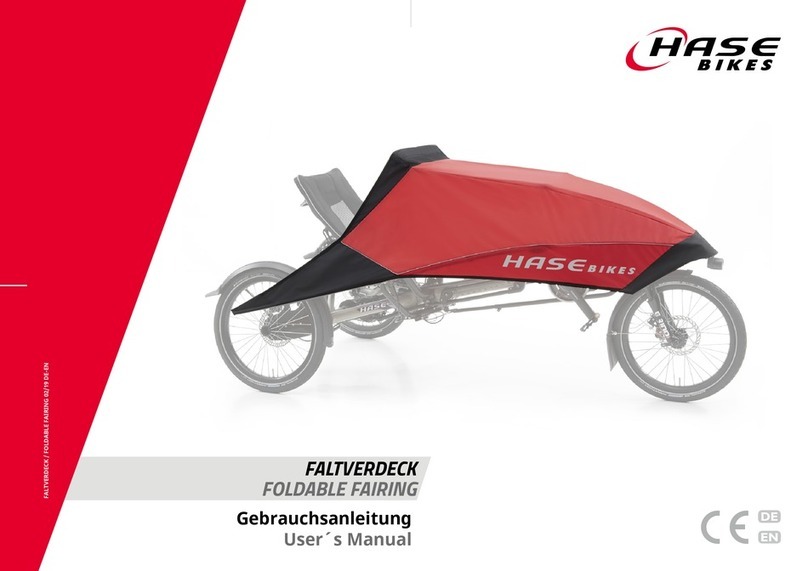
HASE Bikes
HASE Bikes KETTWIESEL User manual
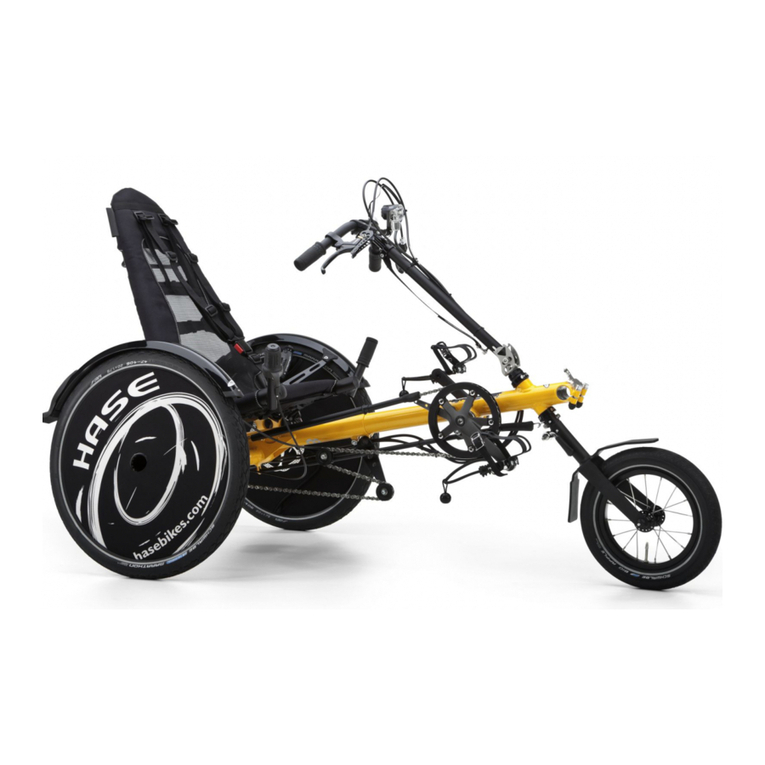
HASE Bikes
HASE Bikes TRETS REH User manual
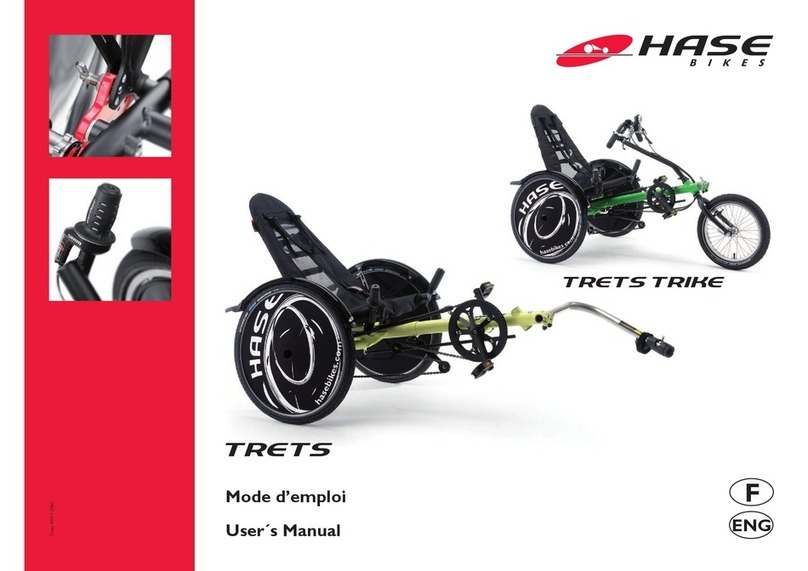
HASE Bikes
HASE Bikes TRETS TRIKE User manual
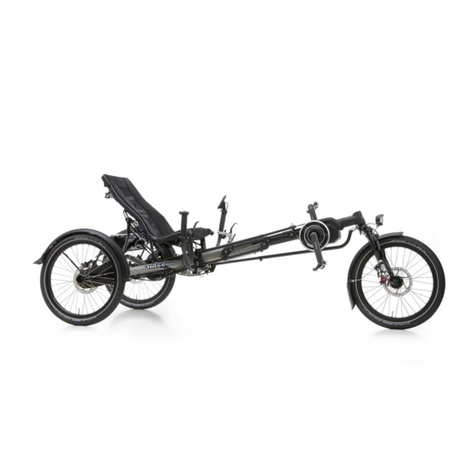
HASE Bikes
HASE Bikes KETTWIESEL User manual
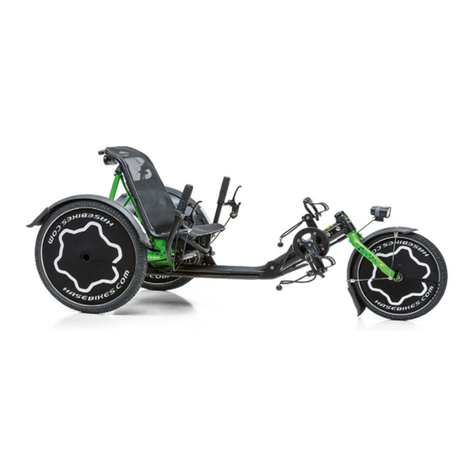
HASE Bikes
HASE Bikes TRETS User manual

HASE Bikes
HASE Bikes HANDBIKE How to use
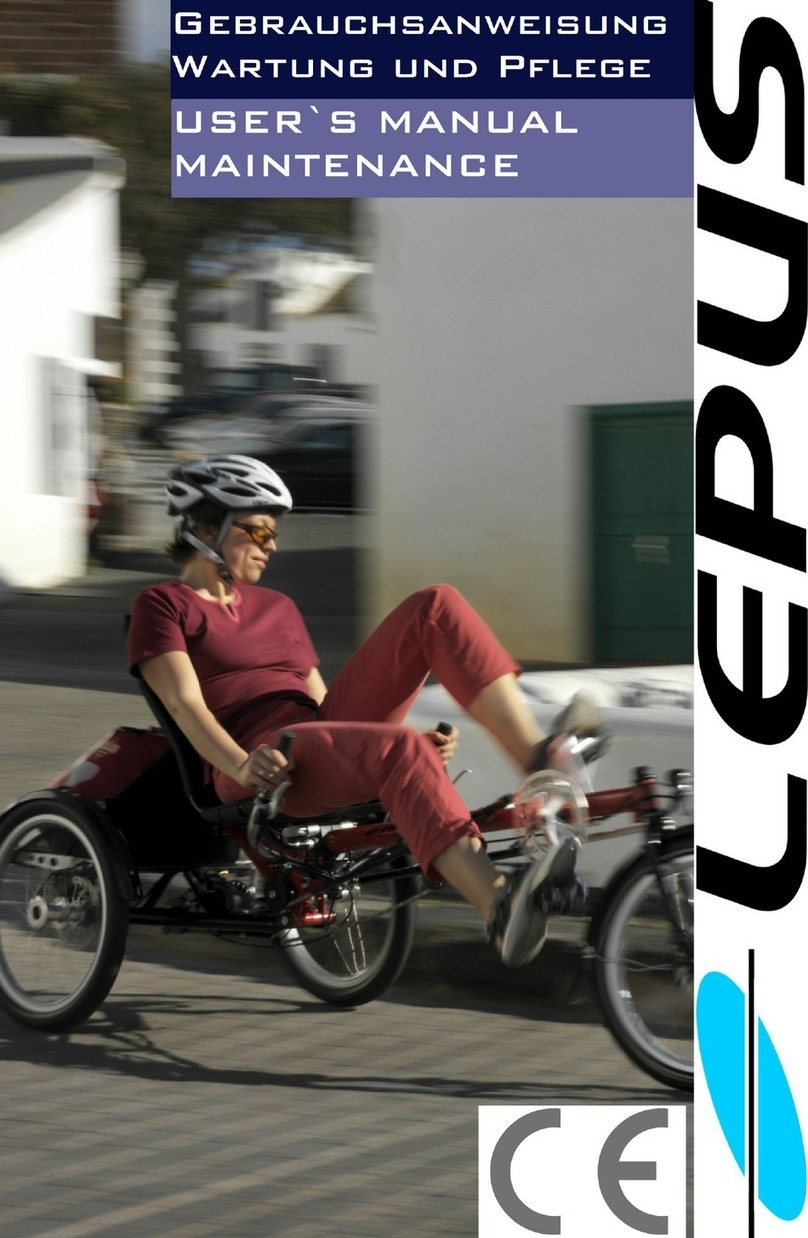
HASE Bikes
HASE Bikes LEPUS User manual
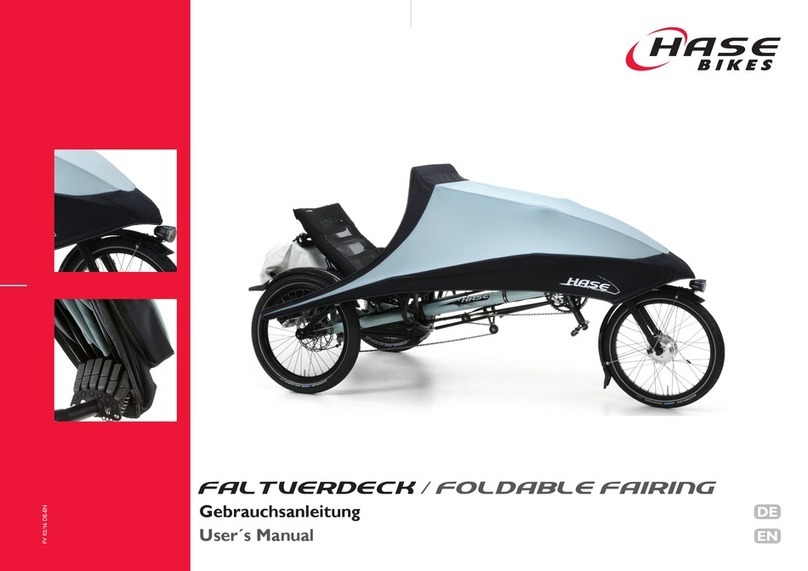
HASE Bikes
HASE Bikes Foldable Fairing User manual
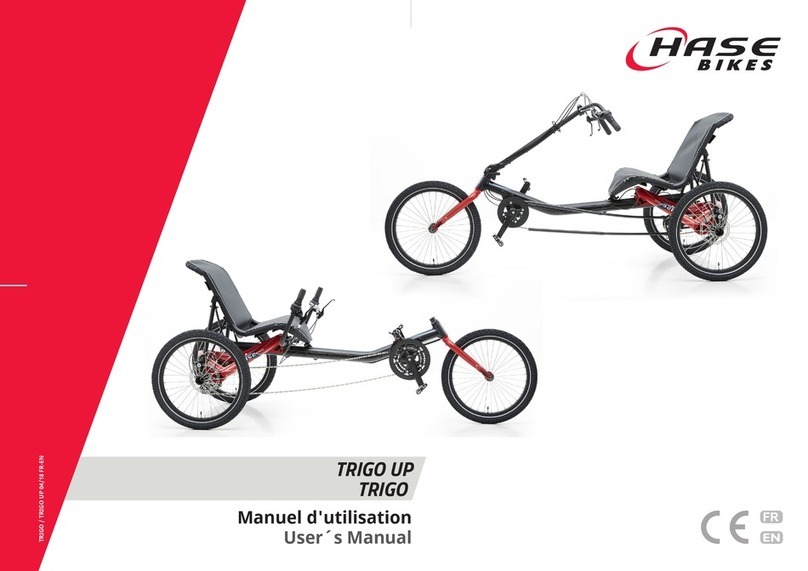
HASE Bikes
HASE Bikes TRIGO UP User manual
